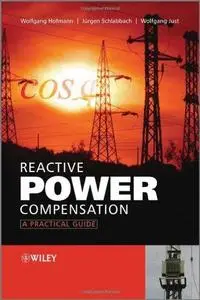Reactive Power Compensation: A Practical Guide By Wolfgang Hofmann, Jurgen Schlabbach, Wolfgang Just(auth.)
2012 | 285 Pages | ISBN: 0470977183 | PDF | 7 MB
2012 | 285 Pages | ISBN: 0470977183 | PDF | 7 MB
The comprehensive resource on reactive power compensation, presenting the design, application and operation of reactive power equipment and installations The area of reactive power compensation is gaining increasing importance worldwide. If suitably designed, it is capable of improving voltage quality significantly, meaning that losses in equipment and power systems are reduced, the permissible loading of equipment can be increased, and the over-all stability of system operation improved. Ultimately, energy use and CO2 emisson are reduced. This unique guide discusses the effects of reactive power on generation, transmission and distribution, and looks at the compensation of existing installations in detail. It outlines methods for determination of reactive power and answers the questions that arise when controlling it, for example, at parallel operation with generators. There is also a chapter devoted to installation, maintenance and disturbances. Key features include: A concise overview as well as deep specific knowledge on the segment power factor regulation and network quality Theory of reactive power compensation coupled with typical application examples such as car manufacturing, metal rolling and chemical works Chapter summaries with charts explaining how to put the theory into practice Coverage on the cost-saving aspects of this technology, including the efficient use of energy and the reduction of CO2 A practical guide for electrical engineers and technicians in utilities, this is also essential reading for maintenance engineers, designers, electrical contractors, manufacturing companies, and researchers, also those in industry and planning agencies. Insightful and clear, the book will also appeal to senior undergraduate and graduate electrical engineering students and professors.Content: Chapter 1 Basics of Reactive Power (pages 1–13): Chapter 2 Reactive Power Consumers (pages 15–21): Chapter 3 Effect of Reactive Power on Electricity Generation, Transmission and Distribution (pages 23–35): Chapter 4 Reactive Power in Standard Energy Contracts (pages 37–42): Chapter 5 Methods for the Determination of Reactive Power and Power Factor (pages 43–51): Chapter 6 Improvement of Power Factor (pages 53–59): Chapter 7 Design, Arrangement and Power of Capacitors (pages 61–73): Chapter 8 Determination of Required Power of Capacitors (pages 75–85): Chapter 9 Types of Reactive Power Compensation (pages 87–115): Chapter 10 Compensation of Existing Installations (pages 117–122): Chapter 11 Control of Reactive Power (pages 123–146): Chapter 12 Discharging Devices for Power Capacitors (pages 147–156): Chapter 13 Protection of Capacitors and Compensations (pages 157–163): Chapter 14 Switching of Capacitors (pages 165–175): Chapter 15 Installation, Disturbances and Maintenance (pages 177–187): Chapter 16 Reactive Power Compensation in Electrical Plants with Generators (pages 189–194): Chapter 17 Effects of Perturbation Considering Especially the Impact of Harmonics on Power Factor Correction Capacitors (pages 195–204): Chapter 18 Resonances in Electrical Power Systems (pages 205–212): Chapter 19 Reactor?Protected Capacitors and Filter Circuits (pages 213–239): Chapter 20 Dynamic Reactive Power Compensation Systems (pages 241–252): Chapter 21 Compensation Effects at Rectifiers (pages 253–261): Chapter 22 Environmental and Climate Protection Using Capacitors (pages 263–267):



